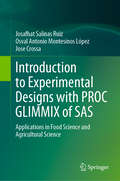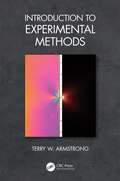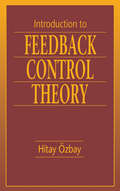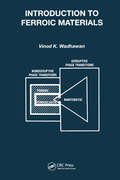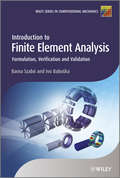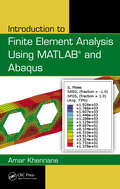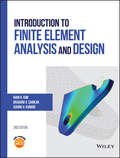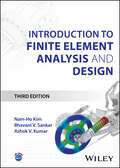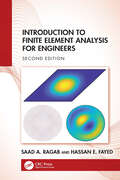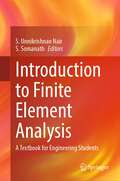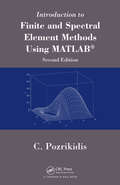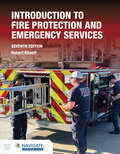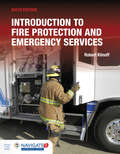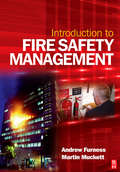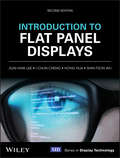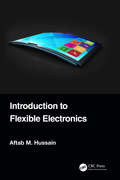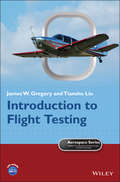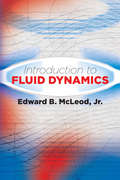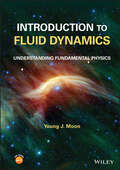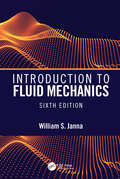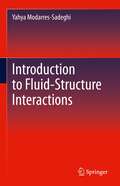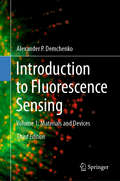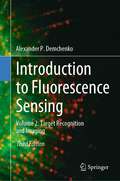- Table View
- List View
Introduction to Experimental Designs with PROC GLIMMIX of SAS: Applications in Food Science and Agricultural Science
by Osval Antonio Montesinos López Josafhat Salinas Ruíz Jose CrossaIn this book, the subject of design and analysis of experiments has been covered in simple language by giving basic concepts of various designs and essential data analysis steps of designed experiments. It has become clear that among researchers, mainly from the areas of food and agricultural sciences, there is a great need for a reference work on design and analysis of experiments that covers basic concepts, provides examples of varied situations that require the use of the experimental designs and that offers clear steps required for the correct analysis execution. This book covers such needs while also sharing codes in the Statistical Analysis Systems (SAS) for each of the designs covered using Proc Glimmix to perform the analysis. It is hoped that this will allow readers to directly analyze the data from their experiments.
Introduction to Experimental Methods
by Terry W. ArmstrongIntroduction to Experimental Methods succinctly explains fundamental engineering concepts in mechanics, dynamics, heat transfer, and fluid dynamics. From conceptualizing an engineering experiment to conducting a comprehensive lab, this book enables students to work through the entire experimental design process.Offering a complete overview of instruction for engineering lab methodology, the book includes practical lab manuals for student use, directly complementing the instruction. Numerous worked examples and problems are presented along with several hands-on experiments in individual lab manuals. This book discusses how to write lab reports, how to configure a variety of instruments and equipment, and how to work through failures in experimentation.Introduction to Experimental Methods is intended for senior undergraduate engineering students taking courses in Experimental Methods. Instructors will be able to utilize a Solutions Manual for their course.Features: Provides an overview of experimental methods in mechanics, dynamics, heat transfer, and fluid dynamics Covers design of experiments, instruments, and statistics Discusses SolidWorks and PASCO Capstone software Includes numerous end-of-chapter problems and worked problems Features a Solutions Manual for instructor use
Introduction to Feedback Control Theory
by Hitay OzbayThere are many feedback control books out there, but none of them capture the essence of robust control as well as Introduction to Feedback Control Theory. Written by Hitay Özbay, one of the top researchers in robust control in the world, this book fills the gap between introductory feedback control texts and advanced robust control texts.Introduction to Feedback Control Theory covers basic concepts such as dynamical systems modeling, performance objectives, the Routh-Hurwitz test, root locus, Nyquist criterion, and lead-lag controllers. It introduces more advanced topics including Kharitanov's stability test, basic loopshaping, stability robustness, sensitivity minimization, time delay systems, H-infinity control, and parameterization of all stabilizing controllers for single input single output stable plants. This range of topics gives students insight into the key issues involved in designing a controller.Occupying and important place in the field of control theory, Introduction to Feedback Control Theory covers the basics of robust control and incorporates new techniques for time delay systems, as well as classical and modern control. Students can use this as a text for building a foundation of knowledge and as a reference for advanced information and up-to-date techniques
Introduction to Ferroic Materials
by Vinod WadhawanFerroic materials are important, not only because of the improved understanding of condensed matter, but also because of their present and potential device applications. This book presents a unified description of ferroic materials at an introductory level, with the unifying factor being the occurrence of nondisruptive phase transitions in crystals
Introduction to Finite Element Analysis
by Barna Szabó Ivo BabuškaWhen using numerical simulation to make a decision, how can its reliability be determined? What are the common pitfalls and mistakes when assessing the trustworthiness of computed information, and how can they be avoided?Whenever numerical simulation is employed in connection with engineering decision-making, there is an implied expectation of reliability: one cannot base decisions on computed information without believing that information is reliable enough to support those decisions. Using mathematical models to show the reliability of computer-generated information is an essential part of any modelling effort.Giving users of finite element analysis (FEA) software an introduction to verification and validation procedures, this book thoroughly covers the fundamentals of assuring reliability in numerical simulation. The renowned authors systematically guide readers through the basic theory and algorithmic structure of the finite element method, using helpful examples and exercises throughout.Delivers the tools needed to have a working knowledge of the finite element methodIllustrates the concepts and procedures of verification and validation Explains the process of conceptualization supported by virtual experimentationDescribes the convergence characteristics of the h-, p- and hp-methods Covers the hierarchic view of mathematical models and finite element spaces Uses examples and exercises which illustrate the techniques and procedures of quality assurance Ideal for mechanical and structural engineering students, practicing engineers and applied mathematiciansIncludes parameter-controlled examples of solved problems in a companion website (www.wiley.com/go/szabo)
Introduction to Finite Element Analysis Using MATLAB and Abaqus
by Amar KhennaneThere are some books that target the theory of the finite element, while others focus on the programming side of things. Introduction to Finite Element Analysis Using MATLAB and Abaqus accomplishes both. This book teaches the first principles of the finite element method. It presents the theory of the finite element method while maintaining a balan
Introduction to Finite Element Analysis and Design
by Bhavani V. Sankar Nam H. Kim Ashok V. KumarIntroduces the basic concepts of FEM in an easy-to-use format so that students and professionals can use the method efficiently and interpret results properly Finite element method (FEM) is a powerful tool for solving engineering problems both in solid structural mechanics and fluid mechanics. This book presents all of the theoretical aspects of FEM that students of engineering will need. It eliminates overlong math equations in favour of basic concepts, and reviews of the mathematics and mechanics of materials in order to illustrate the concepts of FEM. It introduces these concepts by including examples using six different commercial programs online. The all-new, second edition of Introduction to Finite Element Analysis and Design provides many more exercise problems than the first edition. It includes a significant amount of material in modelling issues by using several practical examples from engineering applications. The book features new coverage of buckling of beams and frames and extends heat transfer analyses from 1D (in the previous edition) to 2D. It also covers 3D solid element and its application, as well as 2D. Additionally, readers will find an increase in coverage of finite element analysis of dynamic problems. There is also a companion website with examples that are concurrent with the most recent version of the commercial programs. Offers elaborate explanations of basic finite element procedures Delivers clear explanations of the capabilities and limitations of finite element analysis Includes application examples and tutorials for commercial finite element software, such as MATLAB, ANSYS, ABAQUS and NASTRAN Provides numerous examples and exercise problems Comes with a complete solution manual and results of several engineering design projects Introduction to Finite Element Analysis and Design, 2nd Edition is an excellent text for junior and senior level undergraduate students and beginning graduate students in mechanical, civil, aerospace, biomedical engineering, industrial engineering and engineering mechanics.
Introduction to Finite Element Analysis and Design
by Nam-Ho Kim Bhavani V. Sankar Ashok V. KumarA clear and accessible overview of the Finite Element Method The finite element method (FEM), which involves solutions to partial differential equations and integro-differential equations, is a powerful tool for solving structural mechanics and fluid mechanics problems. FEM results in versatile computer programs with flexible applications, usable with minimal training to solve practical problems in a variety of engineering and design contexts. Introduction to Finite Element Analysis and Design offers a comprehensive yet readable overview of both theoretical and practical elements of FEM. With a greater focus on design aspects than most comparable volumes, it’s an invaluable introduction to a key suite of software and design tools. The third edition has been fully updated to reflect the latest research and applications. Readers of the third edition of Introduction to Finite Element Analysis and Design will find: 50% more exercise problems than the previous edition, with an accompanying solutions manual for instructorsA brand-new chapter on plate and shell finite elementsTutorials for commercial finite element software, including MATLAB, ANSYS, ABAQUS, and NASTRAN Introduction to Finite Element Analysis and Design is ideal for advanced undergraduate students in finite element analysis- or design-related courses, as well as for researchers and design engineers looking for self-guided tools.
Introduction to Finite Element Analysis for Engineers
by Saad A. Ragab Hassan E. FayedNow in its second edition, Introduction to Finite Element Analysis for Engineers is an essential introduction to FEA as a method to solve differential equations. With many practical examples focusing on both solid mechanics and fluid mechanics, it includes problems for both applications.Using a structure of classes of differential equations, the book also includes MATLAB® codes and aims to build a comprehensive understanding of FEA and its applications in modern engineering. New chapters present finite-element models of a system of partial differential equations in two or more independent variables typified by problems in theory of elasticity and plates. Chapter ten presents the finite element method for a nonlinear Mindlin-Reissner plate, and panel flutter is included as a typical example of fluid-structure interactions. The book demonstrates the power and versatility of FEA as a tool with a large number of examples of practical engineering problems. These problems range from those which can be solved without a computer, to those requiring MATLAB® or Python.With applications in civil, mechanical, aerospace, and biomedical engineering, the textbook is ideal for senior undergraduate and first-year graduate students and also aligns with mathematics courses.
Introduction to Finite Element Analysis: A Textbook for Engineering Students
by S. Unnikrishnan Nair S. SomanathThis textbook covers the basic concepts and applications of finite element analysis. It is specifically aimed at introducing this advanced topic to undergraduate-level engineering students and practicing engineers in a lucid manner. It also introduces a structural and heat transfer analysis software FEASTSMT which has wide applications in civil, mechanical, nuclear and automobile engineering domains. This software has been developed by generations of scientists and engineers of Vikram Sarabhai Space Centre and Indian Space Research Organisation. Supported with many illustrative examples, the textbook covers the classical methods of estimating solutions of mathematical models. The book is written in an easy-to-understand manner. This textbook also contains numeral exercise problems to aid self-learning of the students. The solutions to these problems are demonstrated using finite element software. Furthermore, the textbook contains several tutorials and associated online resources on usage of the FEASTSMT software. Given the contents, this textbook is highly useful for the undergraduate students of various disciplines of engineering. It is also a good reference book for the practicing engineers.
Introduction to Finite and Spectral Element Methods Using MATLAB
by Constantine PozrikidisIncorporating new topics and original material, Introduction to Finite and Spectral Element Methods Using MATLAB, Second Edition enables readers to quickly understand the theoretical foundation and practical implementation of the finite element method and its companion spectral element method. Readers gain hands-on computational experience by using
Introduction to Fire Protection (2nd Edition)
by Robert W. KlinoffDiscover the entire process of becoming a firefighter, beginning with an exploration of the requirements and career opportunities, as well as advice on how to succeed as a proactive member of the fire service. Thoroughly updated to the 2004 Edition of the NFPA fire codes and ordinances, Introduction to Fire Protection, 3E explores such cutting-edge issues as homeland security, goal setting and accomplishment, life safety initiatives, recent laws affecting firefighters, and more. Progressive information on fire protection in the community from both the planning and application standpoints offers readers a well-rounded view of the fire service's function in community risk reduction. Featuring comprehensive coverage, this book provides all the necessary tools for individuals seeking a career in the fire service.
Introduction to Fire Protection and Emergency Services
by Robert KlinoffThe seventh edition of Introduction to Fire Protection and Emergency Services is written to align with the National Fire Academy’s Fire and Emergency Services Higher Education (FESHE) objectives and outcomes for the associate level course, Principles of Emergency Services (C0273).
Introduction to Fire Protection and Emergency Services (Fifth Edition)
by Robert W. KlinoffDesigned for use within courses based on the Fire and Emergency Services in Higher Education (FESHE) Principles of Emergency Services model curriculum, this new Fifth Edition will prepare readers for a career in the fire or emergency services. Introduction to Fire Protection and Emergency Services provides an overview of the fire service, from history and culture to the basics of chemistry and physics, fire protection systems, and strategic and tactical considerations for wildland or structural fires. The Fifth Edition has also been updated to include new or expanded coverage of risk management, Next Generation (NG) 9-1-1, the U.S. Fire Problem from local and federal perspectives, wildfire issues and the impacts of global warming, and much more.
Introduction to Fire Protection and Emergency Services includes Navigate Advantage Access
by Robert KlinoffThe sixth edition of Introduction to Fire Protection and Emergency Services meets and exceeds the National Fire Academy’s Fire and Emergency Services Higher Education (FESHE) course objectives and outcomes for the Associate’s (Core) course called Principles of Emergency Services (C0273). The Sixth Edition delivers future fire service candidates a head start in the competitive selection process by familiarizing students with the selection and training process. In addition, the Sixth Edition provides a comprehensive and concise overview of the broad spectrum of the fire service, from the primary duties of the modern fire department, to emergency incident management, to fire prevention, to department administration.The Sixth Edition reinforces foundational knowledge, including the history and future of the fire service; the chemistry and physics of fire; issues facing the fire and rescue service in the United States; and careers in the fire and emergency services. The entire range of services of the modern fire service is explored, including emergency medical services, hazardous materials response, wildland fires, swiftwater rescue, and urban search and rescue.The Sixth Edition includes:An emphasis on safety and professionalism, which is reinforced through discussions of incident effectiveness, fire fighter ethics, customer service, physical fitness, training, decision making, fire prevention, and behavioral health Organizations that support the fire service are highlighted, including:Firefighter Behavioral Health Alliance.Firefighter Cancer Support Network.Leary Firefighter FoundationDiscussions on Post-Traumatic Stress Disorder (PTSD) and Repeated Exposure to Trauma (RET) and their effects on fire fightersAn expanded discussion of the possible future effects of climate change and the effect on the fire and rescue service
Introduction to Fire Safety Management
by Martin Muckett Andrew FurnessAndrew Furness and Martin Muckett give an introduction to all areas of fire safety management, including the legal framework, causes and prevention of fire and explosions, fire protection measures, fire risk assessment, and fire investigation. Fire safety is not treated as an isolated area but linked into an effective health and safety management system.Introduction to Fire Safety Management has been developed for the NEBOSH Certificate in Fire Safety and Risk Management and is also suitable for other NVQ level 3 and 4 fire safety courses. The text is highly illustrated in full colour, easy to read and supported by checklists, report forms and record sheets. This practical approach makes the book a valuable reference for health and safety professionals, fire officers, facility managers, safety reps, managers, supervisors and HR personnel in companies, as well as fire safety engineers, architects, construction managers and emergency fire services personnel.Andrew Furness CFIOSH, GIFireE, Dip2OSH, MIIRSM, MRSH, is Managing Director of Salvus Consulting Limited who specialise in Fire Safety. He was the chairman of the NEBOSH / IOSH working party that developed the NEBOSH Fire Safety and Risk Management certificate.Martin Muckett MA, MBA, CMIOSH, MIFireE, Dip2OSH, former Principal Health and Safety Advisor to The Fire Service Inspectorate and Principal Fire Safety Officer, Martin is currently Salvus Consulting Limited’s Senior Fire Safety Trainer / Consultant.
Introduction to Flat Panel Displays (Wiley Series in Display Technology #20)
by Shin-Tson Wu Jiun-Haw Lee I-Chun Cheng Hong HuaIntroduction to Flat Panel Displays describes the fundamental physics and materials of major flat panel display technologies including LED, OLED, LCD, PDP and FED and reflective displays. A reference for graduate students and new entrants to the display industry, the book currently covers the basic science behind each display technology and gives solved problems and homework problems in each chapter to aid self-study. With advancements in this field, there is enough change in the FPD industry to justify a second edition. This book offers the latest information on modern display technology and features new developments in OLED materials including phosphorescent, TTA, and TADF OLEDS, white light OLED and light extraction. It provides key information on blue phase, automotive lighting, quantum-dot enhanced LCDS, device configurations and performance, and LEDs, specifically nitrate-based. Application features include OLED for mobile, TV, light and flexible OLED, and reflective display specifically e-paper technology and low power consumption displays.
Introduction to Flexible Electronics
by Aftab M. HussainThe field of flexible electronics has grown rapidly over the last two decades with diverse applications including wearable gadgets and medical equipment. This textbook comprehensively covers the fundamental aspects of flexible electronics along with materials and processing techniques. It discusses topics including flexural rigidity, flexible PCBs, organic semiconductors, nanostructured materials, material reliability, electronic reliability, crystalline and polymer materials, semiconductor processing, and flexible silicon in depth. The text covers advantages, disadvantages, and applications of processes such as sol-gel processing and ink-jet printing. Pedagogical features such as solved problems and unsolved exercises are interspersed throughout the text for better understanding. FEATURES Covers major areas such as materials, physics, processes, and applications of flexible electronics Contains homework problems for readers to understand concepts in an easy manner Discusses, in detail, various types of materials, such as flexible silicon, metal oxides, and organic semiconductors Explains the application of flexible electronics in displays, solar cells, and batteries Includes a section on stretchable electronics This textbook is primarily written for senior undergraduate and graduate students in electrical engineering, electronics, materials science, chemistry, and communication engineering for a course on flexible electronics. Teaching resources are available, including a solutions manual for instructors.
Introduction to Flight Testing (Aerospace Series)
by James W. Gregory Tianshu LiuIntroduction to Flight Testing Introduction to Flight Testing Provides an introduction to the basic flight testing methods employed on general aviation aircraft and unmanned aerial vehicles Introduction to Flight Testing provides a concise introduction to the basic flight testing methods employed on general aviation aircraft and unmanned aerial vehicles for courses in aeronautical engineering. There is particular emphasis on the use of modern on-board instruments and inexpensive, off-the-shelf portable devices that make flight testing accessible to nearly any student. This text presents a clear articulation of standard methods for measuring aircraft performance characteristics. Topics covered include aircraft and instruments, digital data acquisition techniques, flight test planning, the standard atmosphere, uncertainty analysis, level flight performance, airspeed calibration, stall, climb and glide, take-off and landing, level turn, static and dynamic longitudinal stability, lateral-directional stability, and flight testing of unmanned aircraft systems. Unique to this book is a detailed discussion of digital data acquisition (DAQ) techniques, which are an integral part of modern flight test programs. This treatment includes discussion of the analog-to-digital conversion, sample rate, aliasing, and filtering. These critical details provide the flight test engineer with the insight needed to understand the capabilities and limitations of digital DAQ. Key features: Provides an introduction to the basic flight testing methods and instrumentation employed on general aviation aircraft and unmanned aerial vehicles. Includes examples of flight testing on general aviation aircraft such as Cirrus, Diamond, and Cessna aircraft, along with unmanned aircraft vehicles. Suitable for courses on Aircraft Flight Test Engineering. Introduction to Flight Testing provides resources and guidance for practitioners in the rapidly-developing field of drone performance flight test and the general aviation flight test community.
Introduction to Fluid Dynamics
by Edward B. Mcleod Jr.Concise, unified, and logical, this introduction to the study of the basic principles of fluid dynamics emphasizes the statement of problems in mathematical language. In addition to its value as a reference for professional engineers, this volume is suitable for advanced undergraduates and graduate students of mathematics and engineering. Some familiarity with the algebra of vector fields is assumed, and a useful appendix provides a succinct review of vector algebra.An introductory chapter covers fundamental notions from the continuum hypothesis to steady-state flow. Succeeding chapters explore conservation of mass, forces acting on a fluid in equilibrium, dynamic equations of motion, irrotational motion, integration of Euler's equation in special cases, and flows representable by harmonic functions. Additional topics include two dimensional flows, rectilinear vortices, general vortex motion, flows with a free boundary, and compressible fluids.
Introduction to Fluid Dynamics: Understanding Fundamental Physics
by Young J. MoonINTRODUCTION TO FLUID DYNAMICS A concise resource that presents a physics-based introduction to fluid dynamics and helps students bridge the gap between mathematical theory and real-world physical properties Introduction to Fluid Dynamics offers a unique physics-based approach to fluid dynamics. Instead of emphasizing specific problem-solving methodologies, this book explains and interprets the physics behind the theory, which helps mathematically-inclined students develop physical intuition while giving more physically-inclined students a better grasp of the underlying mathematics. Real-world examples and end-of-chapter practice problems are included to further enhance student understanding. Written by a highly-qualified author and experienced educator, topics are covered in a progressive manner, enabling maximum reader comprehension from start to finish. Sample topics covered in the book include: How forces originate in fluids How to define pressure in a fluid in motion How to apply conservation laws to deformable substances How viscous stresses are related to strain rates How centrifugal forces and viscosity play a role in curved motions and vortex dynamics How vortices and centrifugal forces are related in external viscous flows How energy is viscously dissipated in internal viscous flows How compressibility is related to wave and wave speed Students and instructors in advanced undergraduate or graduate fluid dynamics courses will find immense value in this concise yet comprehensive resource. It enables readers to easily understand complex fluid phenomena, regardless of the academic background they come from.
Introduction to Fluid Mechanics, Sixth Edition
by William S. JannaIntroduction to Fluid Mechanics, Sixth Edition, is intended to be used in a first course in Fluid Mechanics, taken by a range of engineering majors. The text begins with dimensions, units, and fluid properties, and continues with derivations of key equations used in the control-volume approach. Step-by-step examples focus on everyday situations, and applications. These include flow with friction through pipes and tubes, flow past various two and three dimensional objects, open channel flow, compressible flow, turbomachinery and experimental methods. Design projects give readers a sense of what they will encounter in industry. A solutions manual and figure slides are available for instructors.
Introduction to Fluid-Structure Interactions
by Yahya Modarres-SadeghiThis timely book introduces the subject of Fluid-Structure Interactions (FSI) to students and professionals. It discusses the major ideas in FSI with the goal of providing the fundamental understanding to the readers who possess limited or no understanding of the subject. The author presents the physics of the problem, rather than focusing on the methods, and discusses the essential methods of analysis. The principle goal of Introduction to Fluid-Structure Interactions is impart to students and practitioner a physical understanding of major topics in fluid-structure interactions: axial flow problems (when the direction of the flow is parallel to the long axis of the structure) and crossflow problems (when the direction of the flow is normal to the long axis of the structure). Facilitating readers’ understanding of both categories, starting with simple 1 DOF systems and continuing to more complicated continuous flexible structures, Introduction to Fluid-Structure Interactions, is ideal for graduate students and practitioners interested in this critical field.Stands as a unique introductory volume to study Fluid-Structure Interactions (FSI);Covers aspects of FSI relevant to Fluid Mechanics, Wind Energy, Ocean Engineering, and Biomedical research;Integrates most recent findings from research on FSI;Emphasizes the physics behind the phenomena in detail;Maximizes readers understanding by beginning with fundamental concepts and developing focus to more complex systems.
Introduction to Fluorescence Sensing: Volume 1: Materials and Devices
by Alexander P. DemchenkoThis book provides systematic knowledge of basic principles in the design of fluorescence sensing and imaging techniques together with critical analysis of recent developments. Fluorescence is the most popular technique in chemical and biological sensing because of its ultimate sensitivity, high temporal and spatial resolution and versatility that enables imaging within the living cells. It develops rapidly in the directions of constructing new molecular recognition units, new fluorescence reporters and in improving sensitivity of response up to detection of single molecules. Its application areas range from control of industrial processes to environment monitoring and clinical diagnostics. Being a guide for students and young researchers, it also addresses professionals involved in active basic and applied research. Making a strong link between education, research and product development, this book discusses prospects for future progress.
Introduction to Fluorescence Sensing: Volume 2: Target Recognition and Imaging
by Alexander P. DemchenkoFluorescence is the most popular technique in chemical and biological sensing because of its ultimate sensitivity, high temporal and spatial resolution and versatility that enables imaging within the living cells. It develops rapidly in the directions of constructing new molecular recognition units, new fluorescence reporters and in improving sensitivity of response up to detection of single molecules. Its application areas range from control of industrial processes to environment monitoring and clinical diagnostics. This book provides systematic knowledge of basic principles in design of fluorescence sensing and imaging techniques together with critical analysis of recent developments. Being a guide for students and young researchers, it also addresses professionals involved in active basic and applied research. Making a strong link between education, research and product development, this book discusses prospects for future progress.
